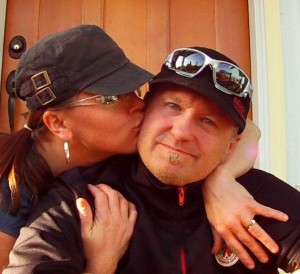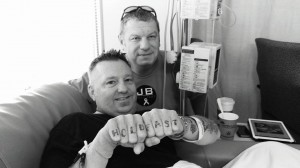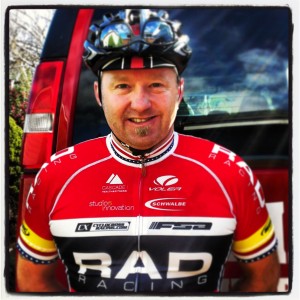To say that Jim Brown is involved in our community would be an understatement.
ThurstonTalk has introduced our readers to Brown on numerous occasions. The first time, back in 2011, we talked about his role as the executive director of Rad Racing, a junior development cycling team. In 2012, Brown talked to us as the founder of the Northwest Classic, a youth focused stage race that has since grown to become one of the largest events of its kind in the country. Last spring, Captain Brown of the Olympia Fire Department told us about some new protocols local Fire/Rescue and Law Enforcement departments were instituting.
 His impact in Thurston County is huge. That’s why, when Jim Brown got a life altering call on May 6, 2015, hundreds of people stepped up to support him.
His impact in Thurston County is huge. That’s why, when Jim Brown got a life altering call on May 6, 2015, hundreds of people stepped up to support him.
That call confirmed that the nagging cough he first thought was bronchitis then thought might be sarcoidosis was actually Lung Cancer – Stage IV Metastatic Mucinous Adenocarcinoma. At his first meeting with an oncologist, Brown was told what he had was incurable and that he would die. That’s when he decided he needed to find a different doctor and that he was going to be the exception, that miracles can happen.
With his wife Regina nodding in agreement, Brown states unequivocally that when someone gives you a death sentence, you can either accept it and die, or walk away and find someone who will fight for you. He found the right doctor in Keith Eaton at Seattle Cancer Care Alliance (SCCA).
You’ve got “to really go the extra mile to get your doctor to invest himself in you – to get to know your doctor – for your doctor to want you to survive as much as you want to survive. That’s what I’ve established with Dr. Eaton,” says Brown.
So far Brown has endured 16 rounds of chemotherapy and has scans roughly every 6 weeks. Now a year past diagnosis, the cancer is stable and has shown no progression.

Starting with a baseline of 7 square centimeters of disease at the beginning of treatment last summer, it is down to 1.6 square centimeters and has been at this level of stabilization for over 6 months. “There is no active disease in my lungs,” he told friends and family in a blog post. There “only appears to be cancer left in one lymph node, and the disease that has spread to my bones shows itself to be stable and continues to show evidence of healing.”
“I try to personalize it with my doctor,” he says. “At the end of my appointment I’ll say ‘Okay, so if this was you, would you be doing anything different?” And he trusts that Eaton will shoot straight with him.
Brown has always been assertive about his health. A lifelong athlete, he is used to pushing his body as well as listening to it. “I monitor my resting heart rate all the time. During one period of time when I was stressed out, I’d go in to talk to the doc and say ‘I’m sure 9 out of 10 guys don’t worry about this … but … and he was like ‘Yeah, try one in a million. I don’t think I’ve ever had anyone come into my office and have one of the things they’re worried about be their resting heart rate.’”
But it’s that attention to detail and willingness to be proactive that is helping Brown stay ahead of his disease. Earlier this year he took a trip to Colorado to meet with a doctor who specializes in the type of genetic mutation (ROS1) that characterizes his cancer.
“I wanted to have the answers ahead of time before having to make a treatment decision. It was crisis for the first four to five months. Now we’ve gotten through the crisis and we’re in management. I know that at some point in time I’m going to have to make a change in my treatment, and I’ve got some options that have been laid out to me.” He has plans to meet with another ROS1 expert on the east coast in August.
“I was interviewed recently for a waiting room type magazine and the lady was asking me what tips I had for people,” he says. “Advocating for yourself as a patient is a really big deal. If you just let the health care system do it for you …” his voice trails off.

Regina believes it’s not just the chemo that is helping her husband but also some of the alternative therapies he’s using. “Those, in tandem with his mental state, are making the difference,” she insists. In addition to chemo, Brown gets regular massage and chiropractic care. He sees a therapist on a regular basis to deal with the psychological effects his disease can have, and he consults with a nutritionist to make sure he is taking care of his dietary needs. During our interview, Regina Brown sits at their kitchen table crushing up a week’s worth of supplements and medications before transferring them into packets for Jim to mix with a drink during his work day. “She,” says Brown, “Is my rock.” He points to his wife and his three daughters as the primary motivation for his drive to be well.
Brown himself continues to be a rock to those who already know him and now to a new group of people – other cancer patients – as well. “You can’t know what it’s like to be in the club until you’re in the club,” he says.
He was recently approached by the Bonnie J. Addario Lung Cancer Foundation about serving on their patient advisory board. When he and Regina were in research mode last summer, they discovered the foundation and received invaluable advice, particularly about genetic mutation testing. On a recent trip to California with some of his junior cyclists, Brown stopped by the Foundation headquarters to thank them in person. “They have done a lot to encourage me and point me in the right direction,” he says. He is excited at the prospect of advocating for others who are given the type of prognosis he was.
Early this spring, he was asked to speak to the freshman health classes at Black Hills High School. The topic was dealing with adversity and being resilient. “Lisa Summers (the teacher) came to me about doing it,” explains Jim. “I didn’t open with the fact that I have cancer.” Instead, he talked about the things he does when dealing with the young athletes he coaches – taking charge of the elements in your life that you actually have control over then letting the rest fall into place. Then he told them about his diagnosis and “how I’m applying the things I was just talking about to my life.”

Perhaps the most important work he is doing right now, though, involves his professional life.
Jim Brown’s cancer has been classified as an on the job injury. As a career firefighter, Brown had to prove that his cancer was caused by on the job exposure, and although the Olympia Fire Department and City of Olympia were, in Brown’s words, “awesome,” moving his case through in record time, not all firefighters are as lucky. The International Association of Fire Fighters (IAFF) is fighting for presumptive legislation so that lung and other cancers are covered for firefighters everywhere. They reached out to him and Brown was recently featured in a video produced by the IAFF.
Part of the process is to educate firefighters about the best practices for disease prevention. “I’m as heavily invested as anyone could possibly be to deliver the information,” he says about new standards for cancer prevention among firefighters. As the Medical Services Officer for the Olympia Fire Department “I’ll be delivering it to our department, but there is talk of me also delivering it to other departments.”
In the meantime, Jim Brown is looking forward. “For a while I was living in six week chunks, especially when I was symptomatic and pretty ill through (last) summer and part of the fall. Now I’ve gained confidence in how I feel and how my scans have been coming out, so we’re going to Boston in August to visit my brother. I wasn’t ready to make those kinds of plans a few months ago.”

The focus now is different. “There is a lot of movement toward chronic disease management for this,” says Brown. “Thirty-five years ago, if you got diagnosed with AIDS, you were dead. Now they have these innovations and people are living with it. We’re getting to the point with lung cancer … it’s getting to be a chronic manageable disease, much like diabetes or AIDS.”
Regina tells me that his response to treatment is “in the words of his doctor this week, miraculous.”
“It’s not ‘curable’ by western standards,” says Brown. That still doesn’t mean that a miracle can’t happen. That’s what I’m looking forward to.”
So are the rest of us.


















































